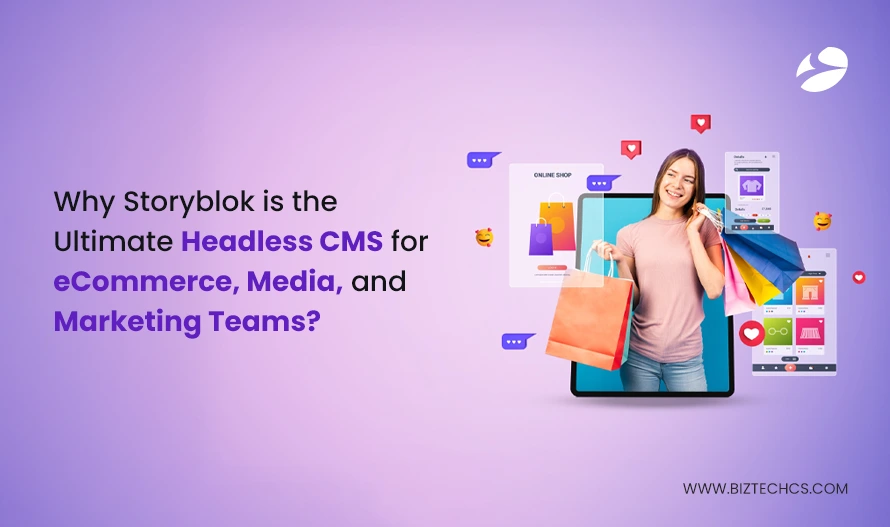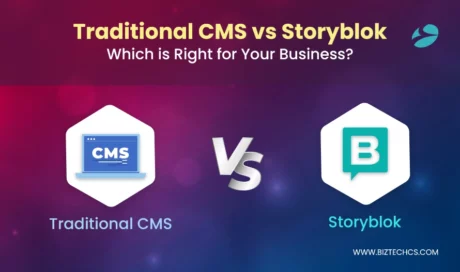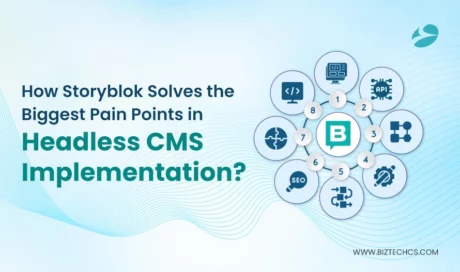35424
Why Storyblok is the Ultimate Headless CMS for eCommerce, Media, and Marketing Teams?
01 Apr, 2025
10 min read
35424
01 Apr, 2025
10 min read
Table Of Content

Every brand today is a publisher—publishing content across websites, apps, and digital campaigns. But juggling speed, scale and consistency with a traditional CMS is no longer practical. That’s why forward-thinking eCommerce, media, and marketing teams are moving to headless architecture.
Among many options, Storyblok has emerged as the most practical and powerful headless CMS for business outcomes. It gives developers and marketers what they want—without compromise.
In this post, we’ll explore how Storyblok solves real-world challenges across industries and why it’s becoming the go-to choice for digital leaders. If your organization wants to scale content operations without slowing down innovation, this is for you.
Traditional CMS platforms were built for websites needing a consistent front end. They combined content management and presentation in one system. This worked well when companies only needed a website or a blog.
But today’s digital needs go far beyond that. Businesses need to deliver content across websites, mobile apps, kiosks, and more.
Traditional CMS platforms struggle with this kind of flexibility. They were not designed to scale across multiple channels or adapt to fast-changing user interfaces.
This is where headless architecture changes the game. In a headless CMS, the content is completely decoupled from the front end, meaning the system only focuses on storing and managing content.
The visual layer—what users see—is handled separately, using modern frameworks. This decoupling makes it easier to reuse content across platforms.
It also gives developers full control over how and where content is shown. For modern businesses, this creates speed, flexibility, and consistency across all digital touchpoints.
A headless eCommerce CMS works like a smart content engine. The content is stored in a central repository, often called the “body.” This body doesn’t care how or where the content will be shown. Instead, it uses APIs to deliver that content to any front end—whether that’s a web store, mobile app, or IoT device.
The front end, or “head,” can be built with the framework that best suits the business goals. Developers can use React, Vue, Angular, or anything else that supports fast modern experiences. This allows businesses to create unique and engaging user interfaces without limitations.
Another benefit is seamless integration. A headless CMS fits nicely with eCommerce platforms like Shopify, BigCommerce, or custom solutions. It also connects easily with CRMs, analytics tool,s and marketing automation systems.
So businesses can keep their tech stack lean and flexible. There will be no more patching systems together or long release cycles.
Content teams can work independently of development, pushing updates without delay. This smart, future-proof approach supports growth across every digital channel.
A headless CMS makes delivering content across every channel your customers use—websites, mobile apps, IoT devices, and even social commerce platforms easier. You don’t need to rewrite or redesign content for each platform.
Instead, you manage content from one place and push it anywhere. This reduces duplication, saves time, and ensures consistency across touchpoints. Your team works smarter, not harder, while customers get a seamless brand experience.
The headless architecture allows for faster page loads, directly boosting SEO and conversion rates. With content and front end decoupled, developers can build high-performance websites using modern frameworks.
This means better loading speeds, smoother interactions and quicker time to market. Your team can roll out changes faster, test new ideas quicker, and iterate without delay. It’s a direct gain in both user experience and internal efficiency.
Headless gives developers full freedom to build without CMS limitations. They can use any front-end framework to optimize performance, accessibility, and UX. Meanwhile marketers can manage content independently using visual editing tools like Storyblok.
This separation removes bottlenecks and speeds up both development and content workflows. Each team moves at its own pace, aligned but not dependent.
With a headless setup, managing content across multiple brands, regions, or websites becomes simple and centralized. You can scale operations without rebuilding your foundation each time. It’s a future-proof approach—ready for new channels, devices, or business models as they emerge.
Your digital infrastructure becomes flexible and resilient, not tied to any one stack. Growth doesn’t slow you down—it becomes easier to handle.
Storyblok brings a unique approach to headless CMS by combining a visual editor with a true headless backend. This gives businesses the best of both worlds—flexibility for developers and ease of use for content teams.
The system is built on a component-based model so that teams can build reusable content blocks. These blocks speed up development and maintain design consistency across channels. Storyblok’s visual editor lets non-technical users create and update content without needing developers.
Meanwhile, developers can focus on code without being interrupted by minor content changes. This dual-power structure helps teams work in parallel, reducing bottlenecks. The result is faster go-to-market timelines and lower development overhead. It’s perfect for companies looking to scale content operations without sacrificing control or creativity.
Storyblok is built for modern developers. It supports all major frontend frameworks, including Next.js, Nuxt, and Svelte. So your dev team can use the stack they know and trust. Storyblok is API-first, offering both REST and GraphQL for maximum flexibility.
Developers can fetch the data they need without over-fetching or bloated responses. It also has built-in versioning, so developers can work without fear of breaking production. Each content item can be staged, reviewed, and published using defined workflows. This reduces last-minute surprises and ensures quality control.
Developers get the tools they need to build fast, secure, and scalable digital products. Storyblok is not just a CMS—it’s a developer-friendly content platform built for speed and collaboration.
Storyblok gives marketing and content teams full independence. The visual editor is intuitive and designed for non-technical users. It allows drag-and-drop editing and real-time previews across devices.
Your team can create and manage landing pages, blogs, and campaigns without writing a single line of code. Content scheduling lets teams plan ahead and release on time. Publishing workflows ensure content is reviewed and approved before it goes live.
No more chasing developers for copy updates or image changes. This speeds up campaigns and reduces dependency on the tech team. With Storyblok, your content team works faster, smarter, and with full confidence in what they’re publishing.
Storyblok makes it easy to manage content at scale. The visual editor lets your team update promotions, lookbooks, and product bundles without developer help. You can build dynamic content blocks and reuse them across different campaigns.
This means faster go-to-market for seasonal offers and launches. Teams can work independently, reducing bottlenecks from technical dependencies. As a result, your product pages stay fresh, consistent, and conversion-driven.
2. Seamless Integration with E-Commerce Platforms
Storyblok connects to platforms like Shopify, BigCommerce, and Magento. Product catalogs, reviews, and customer data can be pulled in and used directly in content experiences. No custom pipelines or workarounds are needed.
Your marketing team can launch content-rich pages using live product data. This reduces friction between systems and teams and keeps your store agile even during peak seasons.
3. Lightning Fast Page Loads and Better SEO
Storyblok’s headless architecture is fast across all devices. It’s built for performance, which means lower bounce rates and better user experience. Technical SEO tools—structured data, meta management, and flexible routing—come built-in.
You don’t need plugins or third-party tools to get found on search engines. Your content loads fast and ranks higher even as your product catalog grows, which is critical for capturing organic traffic in competitive retail markets.
4. Omnichannel Experience Management
With Storyblok, your content isn’t locked to one platform. You can push it to the web, mobile apps, kiosks, or even social channels—without duplicating work. It’s one source of truth for all your product content.
Built-in localization and personalization make it easy to tailor content by region, device or audience segment. Your team can manage everything from one place, at scale. This reduces overhead and increases campaign impact across every channel.
Storyblok enables teams to work on the content together in real time. Each user can be assigned a role with specific permissions—no more accidental edits or access issues. Editors, developers, designers, and marketing leads can all work within one platform without stepping on each other’s toes.
Approval workflows can be customized to fit your internal review process. This means every piece of content goes through the right eye before it goes live. For media and marketing teams handling multiple campaigns, this creates consistency and avoids last-minute chaos.
Storyblok has a visual editor even non-technical users can use. Teams can drag and drop components, see live previews, and publish without developer support. This speeds up campaign launches and reduces internal bottlenecks.
Marketers can focus on messaging and storytelling instead of backend complexity. No-code/low-code means faster experimentation and quicker rollouts, which is a big win for companies with multiple channels and campaigns.
Storyblok lets you schedule content in advance—perfect for product launches, seasonal drops, or time-sensitive campaigns. You can plan weeks in advance and trust the system to publish automatically. Versioning means you can always roll back or review changes with clarity. Marketing teams can also test different content variations with built-in A/B testing. This helps optimize messaging and layout before committing fully. For performance-driven brands, this feature alone can drive more conversions.
Adyen is a global fintech company that handles payments for some of the world’s biggest brands. As they grew, content management across regions became a problem. They needed a solution that allowed local teams to work independently while staying on brand.
With Storyblok, Adyen built a central content hub with local flexibility. Teams can now manage regional content without involving developers for every update, which has greatly reduced launch and campaign turnaround time.
Before Storyblok, marketers had to rely on developers for even minor content updates. This caused delays and bottlenecks, especially during regional rollouts. Storyblok’s visual editor and content blocks changed that.
Now, marketers can create and adjust content without writing code. Developers focus on more strategic tasks, not fixing headlines or images. It’s created a more efficient, scalable workflow across teams.
Adyen operates in over 25 countries. Speed matters when entering new markets or launching updates. With Storyblok’s localization features, they roll out region-specific content in days, not weeks.
Teams can duplicate and adapt content across languages with minimal effort. This gives Adyen a competitive edge in responding to market needs fast. It’s reduced costs and increased speed to market.
Oatly is a brand known for bold messaging and creative campaigns. Managing that creativity across digital platforms was becoming hard to scale. They chose Storyblok for its component-based CMS architecture. Designers and marketers now use reusable content blocks to bring campaigns to life without starting from scratch.
These blocks are flexible yet structured—perfect for balancing creativity with consistency. It’s allowed Oatly to scale content production without losing its voice. Oatly’s brand voice is its power. But keeping that voice consistent across countries and channels was a problem. Storyblok’s content structure enforces brand guidelines without restricting creativity.
Every team, from Sweden to the U.S., works from the same set of approved blocks. This means content feels local but sounds unmistakably Oatly. It’s made scaling global storytelling more controlled and more effective.
Storyblok is the headless CMS for speed, scale, and structure. The visual editor lets marketers work without slowing down developers. The component-based architecture enables true content reusability across channels. For global teams, localization, and workflow features bring control and clarity.
For eCommerce, Storyblok handles product storytelling with precision and flexibility. For media and marketing it delivers brand experiences at scale.
At BiztechCS, we’ve helped enterprises get the most out of Storyblok. If you’re looking for a future-proof CMS for your next digital move, let’s talk.

Artificial Intelligence (AI)
709
By Devik Gondaliya
22 Apr, 2025

Storyblok
34489
By Devik Gondaliya
02 Apr, 2025

Storyblok
35958
By Devik Gondaliya
27 Mar, 2025